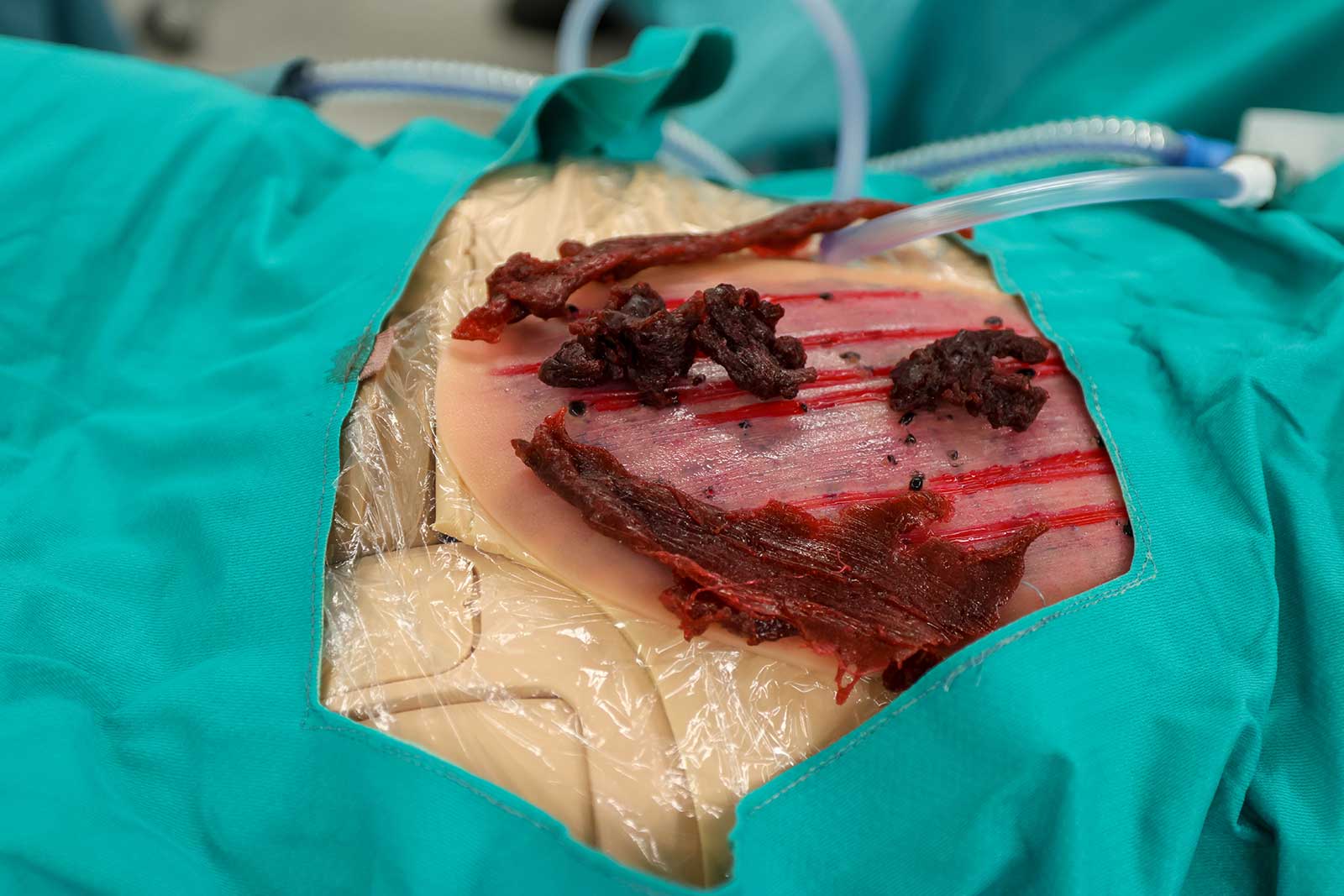Simulation training helps teams prepare for massive bleeding events

July 4, 2024
By Ben Freeland, communications advisor
Suzanne Watts was in her element on May 10, 2024, when the Misericordia Community Hospital conducted its annual operating room (OR) simulation exercise. The clinical nurse educator for the hospital’s post-anesthetic care unit (PACU), Suzanne is a seasoned veteran of simulation exercises, having done them competitively in her former role as a STARS Air Ambulance flight nurse and having focused on them as a master’s student in health sciences education.
“I’m a big proponent of simulations,” says Suzanne. “I really believe they’re a great learning tool, especially when you do them on a large scale with multiple departments and many people and moving pieces. I think there’s a lot to learn from them.”
May 10 was Tom Williams Surgical Research Day, a day on which fewer day surgeries are scheduled. The Misericordia used this opportunity to conduct a simulation centred on the province’s massive hemorrhage protocol (MHP) — a scenario in response to a surgical complication leading to a massive bleed — requiring the response and co-ordination of numerous participants, including OR and PACU nursing staff, lab technicians, respiratory therapists, service attendants and physicians.
“A massive hemorrhage event isn’t an everyday occurrence, but it can happen, and we must be prepared for it,” says Scott Alberts, program manager for operative services at the Misericordia.
“Making sure our teams are prepared for situations like this is very similar to disaster planning. You don't forego it because there might not be a forest fire that summer. Simulations allow for all our teams to participate so that everybody gets an opportunity to go through a process and learn the necessary skills. You never know when you’re going to be called upon to use them.”
In preparation for the May 10 simulation, the team developed an Amazing Race-inspired educational event entitled A-MHP-zing Race, which was carried out on April 26. This gamification approach broke down the protocol into nine stations and one roadblock, which enabled staff to practice each element as part of a combined learning experience, incorporating both theoretical knowledge and hands-on application. A separate session was delivered by the Edmonton Zone transfusion safety officer on May 3, which offered a further overview of the provincial MHP components and nursing considerations.
“The purpose of this preparatory exercise was to give staff the tools necessary to be successful on simulation day,” says Suzanne.
“We know simulations can be very anxiety-inducing for everybody involved, so we did a lot of practical work and education leading up to the simulation so that these wouldn’t be new concepts. We wanted to ensure that every step of the protocol had been practiced ahead.”
The May 10 program consisted of five one-hour simulations involving five different interdisciplinary teams. As with any simulation of this kind, everything was done to replicate an actual surgical situation, from having a simulation mannequin as a patient to using actual OR equipment and Epic charting software on Connect Care. Each simulation was followed by a debriefing session for participants to share what went well and what could be improved.

Surgical teams at the Misericordia hospital used a mannequin to simulate their response to a massive bleeding event.
Any scenario involving massive blood loss is considered a high-risk situation requiring swift action on everyone’s part and absolute precision in communication between teams — particularly in managing blood products. In this particular simulation, personnel from Alberta Precision Labs in the Edmonton Zone were involved in co-ordinating the provision of fake blood components and products that would be prepared in an MHP activation from the Transfusion Medicine Lab to the OR.
“This was a great opportunity for staff on both the nursing side and the lab side to collaborate and practice,” says Tihiro Rymer, Edmonton Zone transfusion safety officer at Alberta Precision Labs.
“It’s not just about the transfusion aspect — of course, it’s important to get blood to the patient quickly — but there’s so much more involved in massive hemorrhage protocol activations. The communication aspect is huge, and simulations like this really help solidify it.”
The overall atmosphere in the OR on the day of the simulations was one of both intense focus and obvious excitement — everybody took their role seriously and seemed to enjoy the process, says Suzanne. They showed tight discipline when the clock was on and completed the simulation at a good pace.
The event organizers say they were pleased with how the event transpired.
“I thought it went amazingly well,” says Tonya Whitney, the clinical nurse educator in the OR and co-organizer of the event. “The simulation itself is a matter of predicting what actions our staff are going to take and then making sure we’ve replicated these actions within the simulation. Understanding the Connect Care component was an important aspect, as we just launched it in May of 2023, and it’s still a work in progress for our staff. Overall, I think everyone became much more familiar with the protocol, which was our overall objective, so it was obviously a win.”
Suzanne concurs, adding that the simulation provided the team with a lot of useful information on how to refine the process.
“We definitely identified some learning gaps that we can do some extra education on,” she says.
“There’s clearly some need for further clarification of the order of workflow, on some of the blood work that needs to be done and on what exactly constitutes the two-person verification required for giving the blood products to a patient. We have quite a few takeaways that we can present to our staff from this simulation. As for staff feedback, the overall takeaway was that staff enjoyed the education series on MHP, and it was a great way for them to learn and remember. As an educator, this is always something you want to hear.